Investigation of the Spray Development Process of Gasoline-Biodiesel Blended Fuel Sprays in a Constant Volume Chamber
Abstract
1. Introduction
2. Experimental Setup and Conditions
2.1. Fuel Properties
2.2. Materials and Method
2.3. Spray Analysis Method
3. Results and Discussions
3.1. Microscopic Spray Characteristics
3.2. Effects of the Properties of the Fuels on the Injection Rate and Correlation with Spray Development
3.3. Macroscopic Spray Characteristics
4. Conclusions
- At the low injection pressure of 40 MPa, low biodiesel ratio fuels of GB00 and GB05 have lower spray velocity by about 60% compared with high biodiesel ratio fuels of GB20 and GB40. Low spray velocity led to a different atomization regime, so spray atomization of GB00 and GB05 was disadvantageous at the initial stage of the spray development.
- As injection pressure increases, spray velocities at the initial spray development becomes similar for all fuels. Under similar spray velocity conditions, low biodiesel ratio fuel was advantageous for spray atomization. This was attributed to the gasoline’s lower kinematic viscosity and surface tension.
- Microscopic spray analysis and macroscopic spray analysis showed similar trends of spray shape, such as the spray tip penetration and the spray cone angle. However, atomization performance was only found by microscopic spray analysis.
- Various ambient conditions should be tested to investigate the whole atomization process, including evaporation, so this should be an objective of further research.
Author Contributions
Funding
Conflicts of Interest
References
- Hiroyasu, H.; Arai, M. Structures of fuel sprays in diesel engines. In SAE Transactions; SAE International: Warrendale, PA, USA, 1990; pp. 1050–1061. [Google Scholar]
- Naber, J.D.; Siebers, D.L. Effects of gas density and vaporization on penetration and dispersion of diesel sprays. In SAE Transactions; SAE International: Warrendale, PA, USA, 1996; pp. 82–111. [Google Scholar]
- Kegl, B.; Lešnik, L. Modeling of macroscopic mineral diesel and biodiesel spray characteristics. Fuel 2018, 222, 810–820. [Google Scholar] [CrossRef]
- Crua, C.; Heikal, M.R.; Gold, M.R. Microscopic imaging of the initial stage of diesel spray formation. Fuel 2015, 157, 140–150. [Google Scholar] [CrossRef]
- Manin, J.; Bardi, M.; Pickett, L.M.; Payri, R. Boundary condition and fuel composition effects on injection processes of high-pressure sprays at the microscopic level. Int. J. Multiph. Flow 2016, 83, 267–278. [Google Scholar] [CrossRef]
- Heimgärtner, C.; Leipertz, A. Investigation of the Primary Spray Breakup Close to the Nozzle of a Common-Rail High Pressure Diesel Injection System; SAE Paper no. 2000-01-1799; SAE International: Warrendale, PA, USA, 2000. [Google Scholar]
- Sjoeberg, H.; Manneberg, G.; Cronhjort, A. Long-working-distance microscope used for diesel injection spray imaging. Opt. Eng. 1996, 35, 3591–3597. [Google Scholar] [CrossRef]
- Bae, C.; Yu, J.; Kang, J.; Kong, J.; Lee, K.O. Effect of Nozzle Geometry on the Common-Rail Diesel Spray; SAE Paper no. 2002-01-1625; SAE International: Warrendale, PA, USA, 2002. [Google Scholar]
- Kalghatgi, G.T.; Risberg, P.; Ångström, H. Partially Pre-Mixed Auto-Ignition of Gasoline To Attain Low Smoke and Low Nox at High Load in a Compression Ignition Engine and Comparison with a Diesel Fuel; SAE Paper 2007-01-0006; SAE International: Warrendale, PA, USA, 2007. [Google Scholar]
- Manente, V.; Johansson, B.; Tunestal, P.; Cannella, W. Effects of Different Type of Gasoline Fuels on Heavy Duty Partially Premixed Combustion; SAE Paper 2009-01-2668; SAE International: Warrendale, PA, USA, 2010; Volume 2, pp. 71–88. [Google Scholar]
- Manente, V.; Zander, C.G.; Johansson, B.; Tunestal, P.; Cannella, W. An Advanced Internal Combustion Engine Concept for Low Emissions and High Efficiency from Idle to Max Load Using Gasoline Partially Premixed Combustion; SAE Paper 2010-01-2198; SAE International: Warrendale, PA, USA, 2010. [Google Scholar]
- Manente, V.; Johansson, B.; Canella, W. Gasoline partially premixed combustion, the future of internal combustion engines? Int. J. Eng. Res. 2011, 12, 194–208. [Google Scholar] [CrossRef]
- Lewander, C.; Johansson, B.; Tunestal, P. Extending the Operating Region of Multi-Cylinder Partially Premixed Combustion Using High Octane Number Fuel; SAE Technical Paper no. 2011-01-1394; SAE International: Warrendale, PA, USA, 2011. [Google Scholar]
- Sellnau, M.; Sinnamon, J.; Hoyer, K.; Husted, H. Full-time gasoline direct-injection compression ignition for high efficiency and low NOx and PM. SAE Int. J. Eng. 2012, 5, 300–314. [Google Scholar] [CrossRef]
- Zhang, F.; Xu, H.; Rezaei, S.Z.; Kalghatgi, G.; Shuai, S.J. Combustion and Emission Characteristics of a PPCI Engine Fuelled with Dieseline; SAE paper 2012-01-1138; SAE International: Warrendale, PA, USA, 2012. [Google Scholar]
- Bohl, T.; Tian, G.; Smallbone, A.; Roskilly, A.P. Macroscopic spray characteristics of next-generation bio-derived diesel fuels in comparison to mineral diesel. Appl. Energy 2017, 186, 562–573. [Google Scholar] [CrossRef]
- EPA. Finalizes Regulations for the National Renewable Fuel Standard Program for 2010 and Beyond-Regulatory Announcement; United States Environmental Protection Agency: Washington, DC, USA, 2010. [Google Scholar]
- Adams, C.A.; Loeper, P.; Krieger, R.; Andrie, M.J.; Foster, D.E. Effects of biodiesel–gasoline blends on gasoline direct-injection compression ignition (GCI) combustion. Fuel 2013, 111, 784–790. [Google Scholar] [CrossRef]
- Misra, R.D.; Murthy, M.S. Blending of additives with biodiesels to improve the cold flow properties, combustion and emission performance in a compression ignition engine—A review. Renew. Sustain. Energy Rev. 2011, 15, 2413–2422. [Google Scholar] [CrossRef]
- U.S. Department of Energy. Biodiesel Handling and Use Guide, 5th ed.; DOE/GO-102016-4875; U.S. Department of Energy: Washington, DC, USA, 2016.
- Tang, C.; Guan, L.; Eng, Z.; Zhan, C.; Yang, K.; Huang, Z. Effect of di-n-butyl ether blending with soybean-biodiesel on the near-nozzle spray characteristics. Fuel 2017, 191, 300–311. [Google Scholar] [CrossRef]
- Wang, X.; Huang, Z.; Kuti, O.A. Experimental and analytical study on biodiesel and diesel spray characteristics under ultra-high injection pressure. Int. J. Heat Fluid Flow 2010, 31, 659–666. [Google Scholar] [CrossRef]
- Fu, W.; Li, F.; Meng, K. Experiment and analysis of spray characteristics of biodiesel blending with di-n-butyl ether in a direct injection combustion chamber. Energy 2019, 185, 77–89. [Google Scholar] [CrossRef]
- Ma, Y.; Huang, R.; Huang, S. Experimental investigation on the effect of n-pentanol blending on spray, ignition and combustion characteristics of waste cooking oil biodiesel. Energy Convers. Manag. 2017, 148, 440–455. [Google Scholar] [CrossRef]
- Hoang, A. Experimental study on spray and emission characteristics of a diesel engine fueled with preheated bio-oils and diesel fuel. Energy 2019, 171, 795–808. [Google Scholar] [CrossRef]
- Mo, J.; Tang, C.; Li, J.; Guan, L.; Huang, Z. Experimental investigation on the effect of n-butanol blending on spray characteristics of soybean biodiesel in a common-rail fuel injection system. Fuel 2016, 182, 391–401. [Google Scholar] [CrossRef]
- Das, S.; Kim, K.; Lim, O. Experimental study on non-vaporizing spray characteristics of biodiesel-blended gasoline fuel in a constant volume chamber. Fuel Process. Technol. 2018, 178, 322–335. [Google Scholar] [CrossRef]
- Zhong, W.; Li, B.; He, Z.; Xuan, T.; Lu, P.; Wang, Q. Experimental study on spray and combustion of gasoline/hydrogenated catalytic biodiesel blends in a constant volume combustion chamber aimed for GCI engines. Fuel 2019, 253, 129–138. [Google Scholar] [CrossRef]
- Chen, H.; Su, X.; Li, J.; Zhong, X. Effects of gasoline and polyoxymethylene dimethyl ethers blending in diesel on the combustion and emission of a common rail diesel engine. Energy 2019, 171, 981–999. [Google Scholar] [CrossRef]
- Putrasari, Y.; Lim, O. A Study on Combustion and Emission of GCI Engines Fueled with Gasoline-Biodiesel Blends. Fuel 2017, 189, 141–154. [Google Scholar] [CrossRef]
- Putrasari, Y.; Lim, O. A study of a GCI engine fueled with gasoline-biodiesel blends under pilot and main injection strategies. Fuel 2018, 221, 269–282. [Google Scholar] [CrossRef]
- Dumouchel, C. On the experimental investigation on primary atomization of liquid streams. Exp. Fluids 2008, 45, 371–422. [Google Scholar] [CrossRef]
- Bekdemir, C. Numerical modeling of Diesel spray formation and combustion. Master’s Thesis, Eindhoven University of Technology, Eindhoven, The Netherlands, 2008. [Google Scholar]

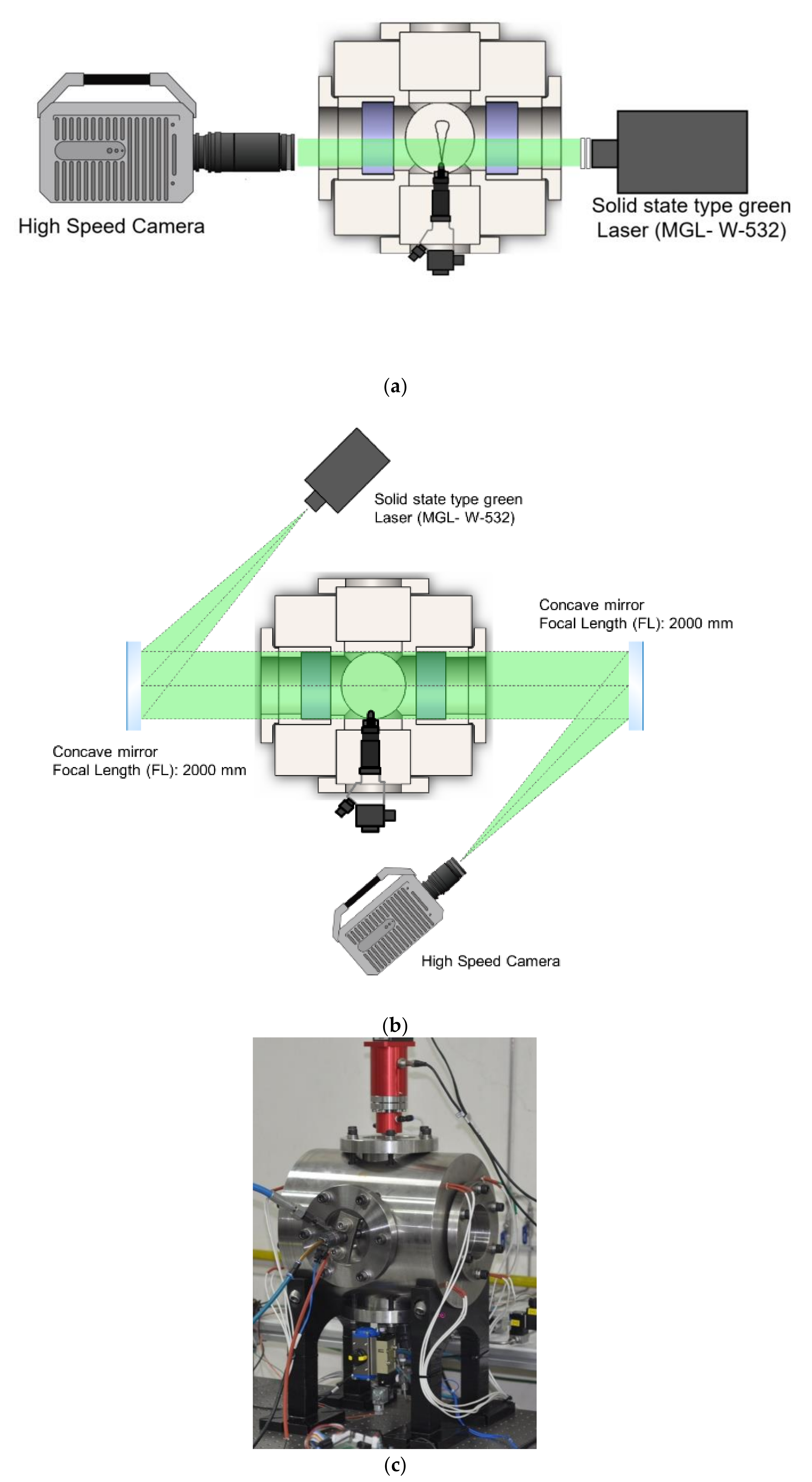
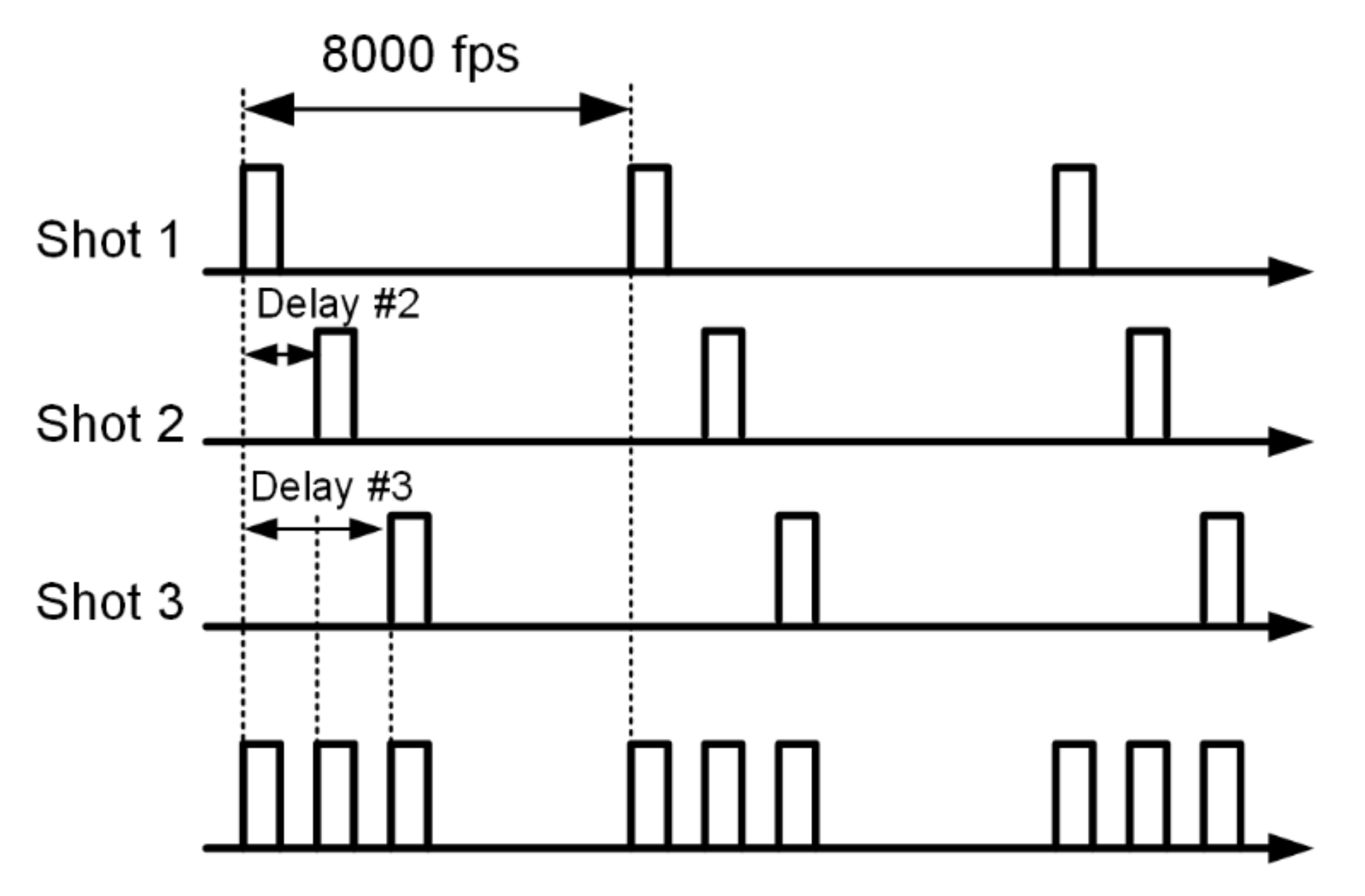
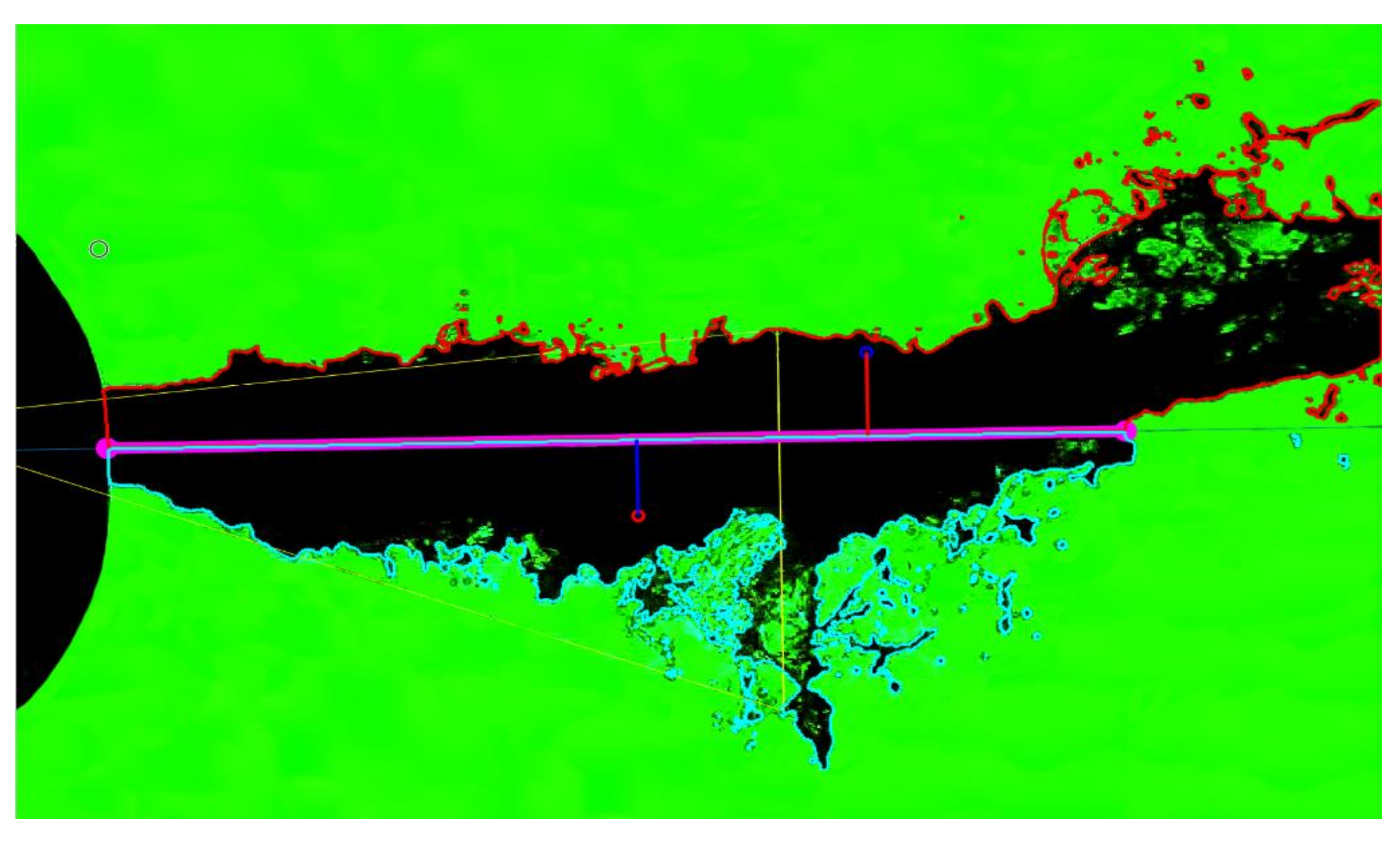
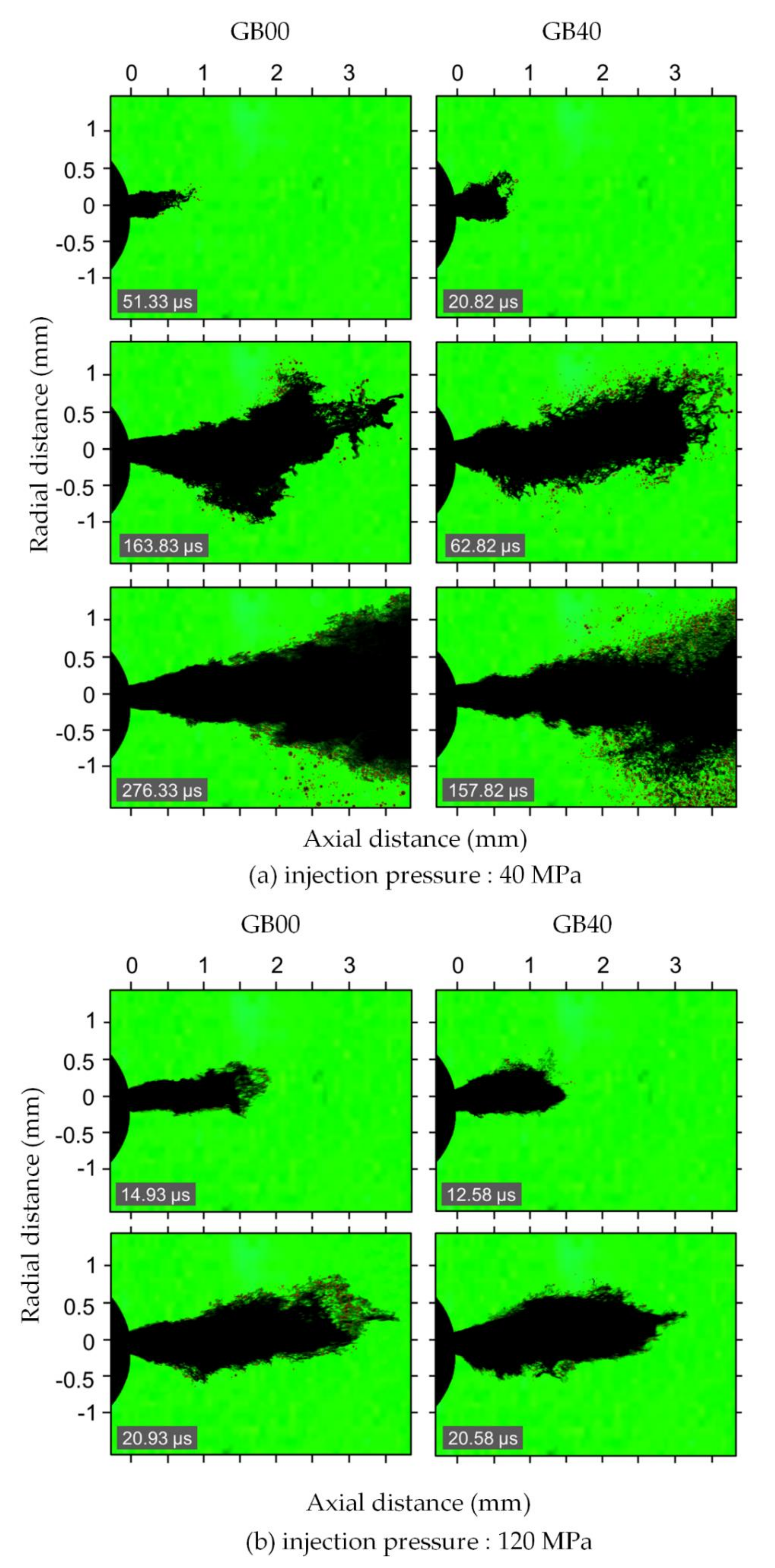
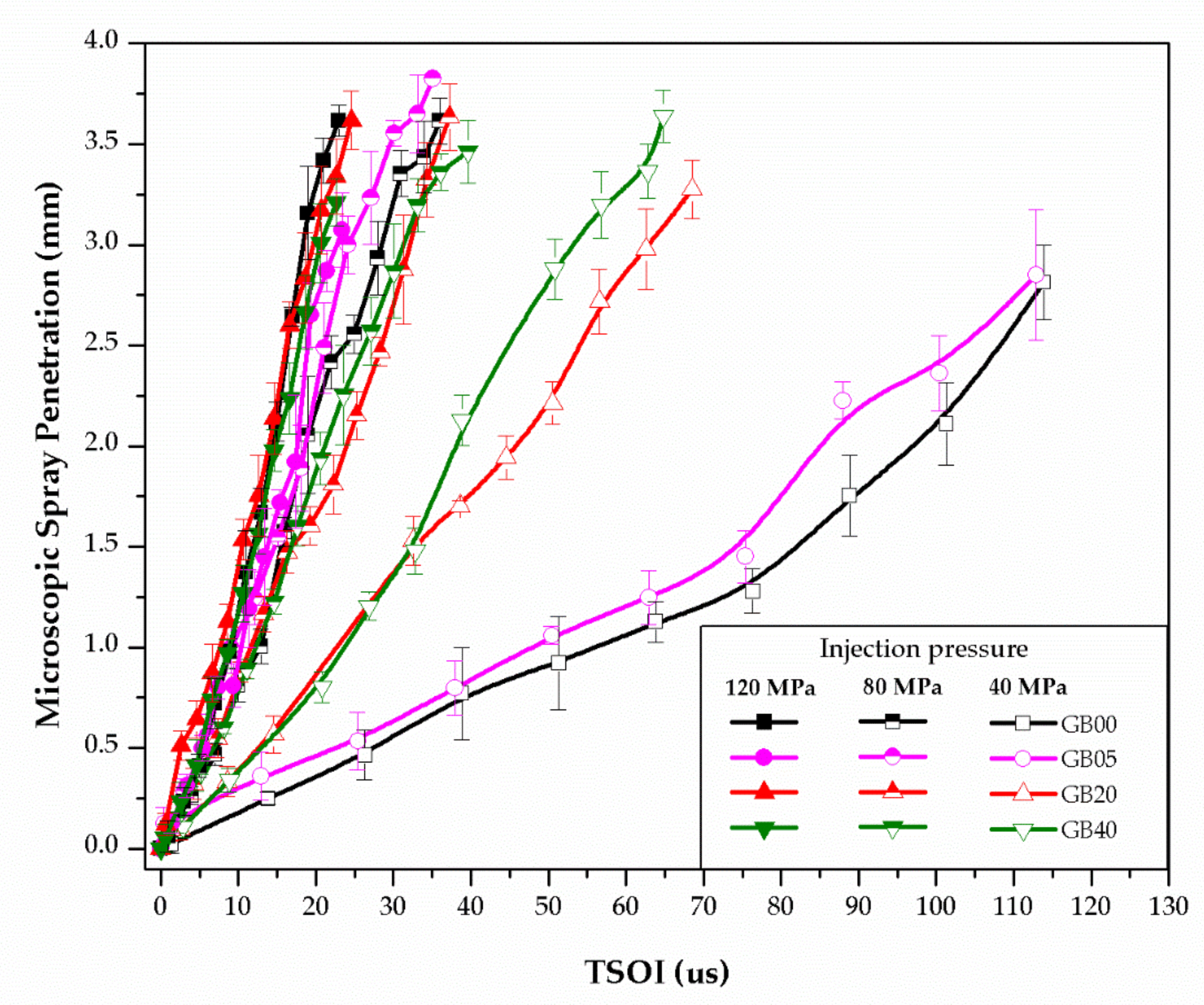
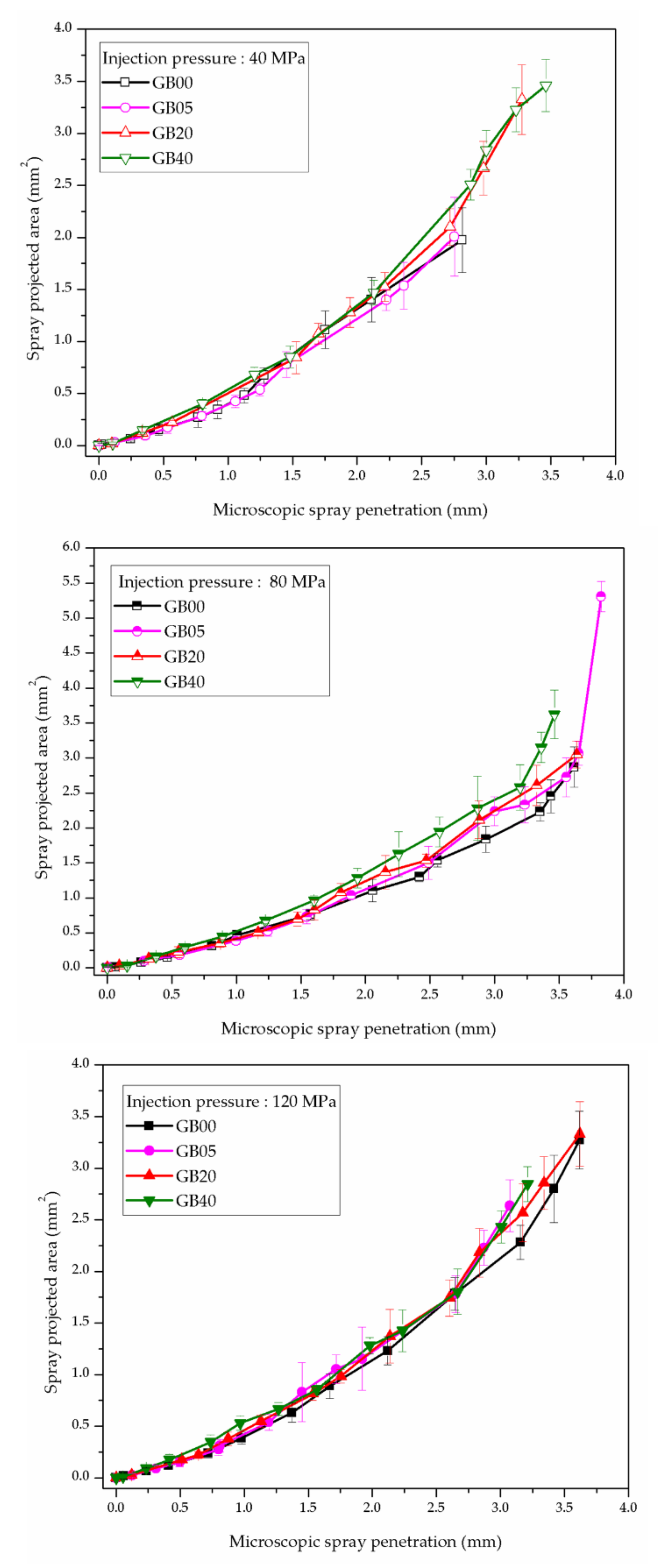
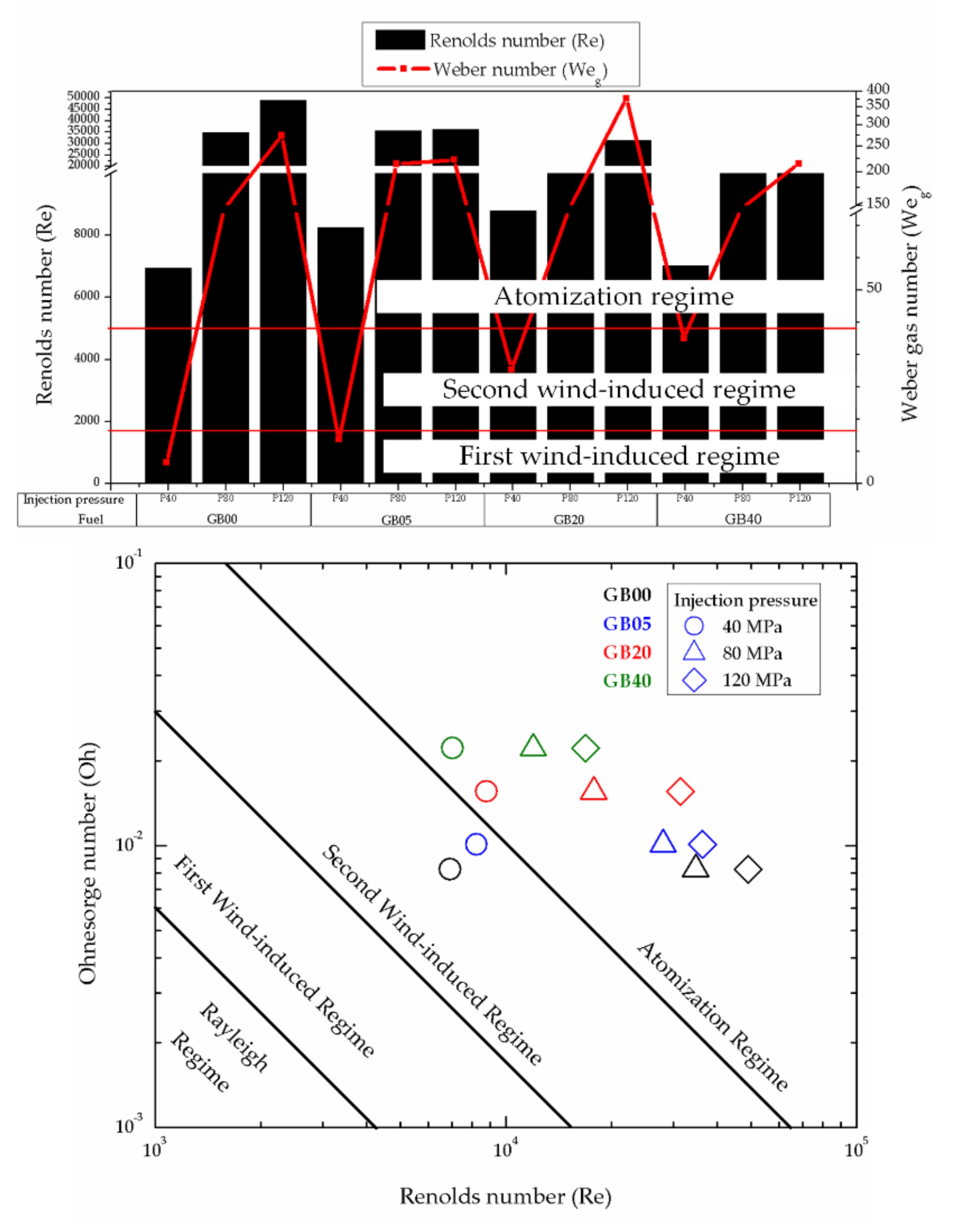
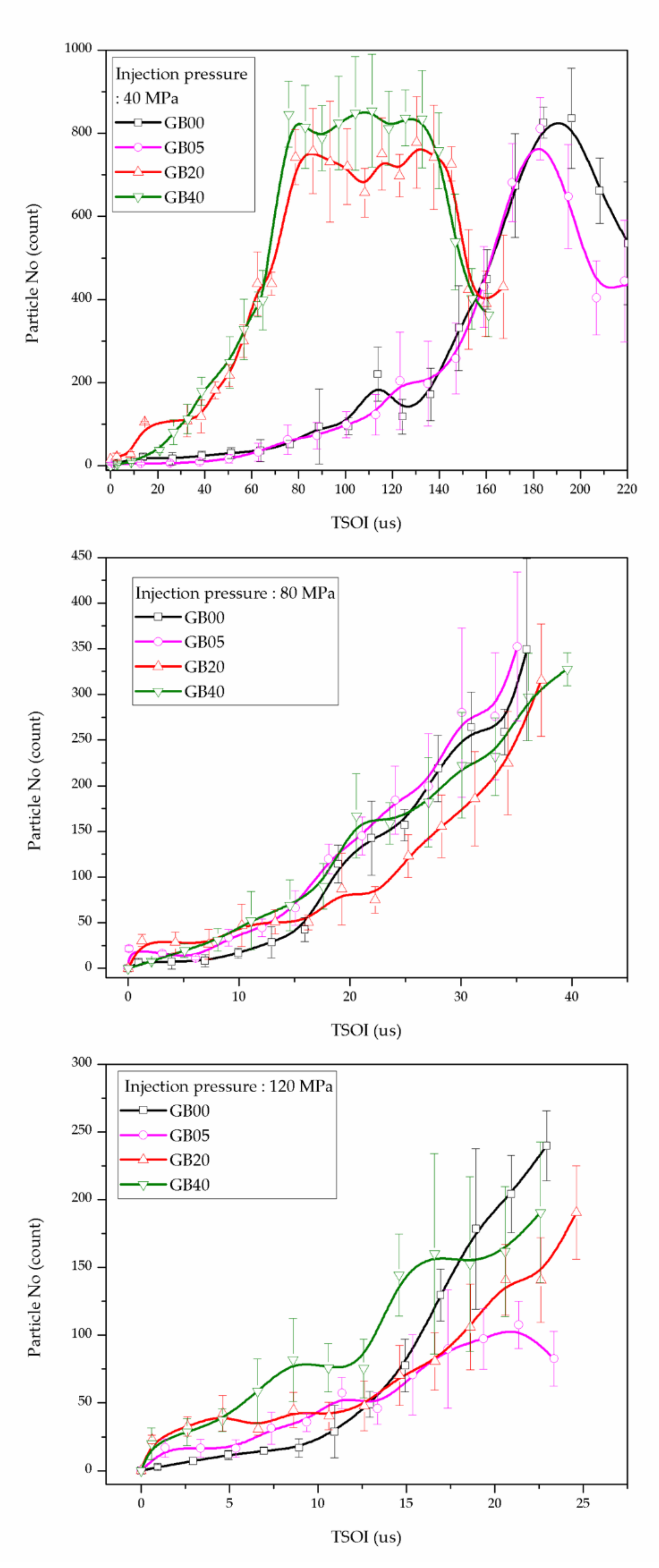

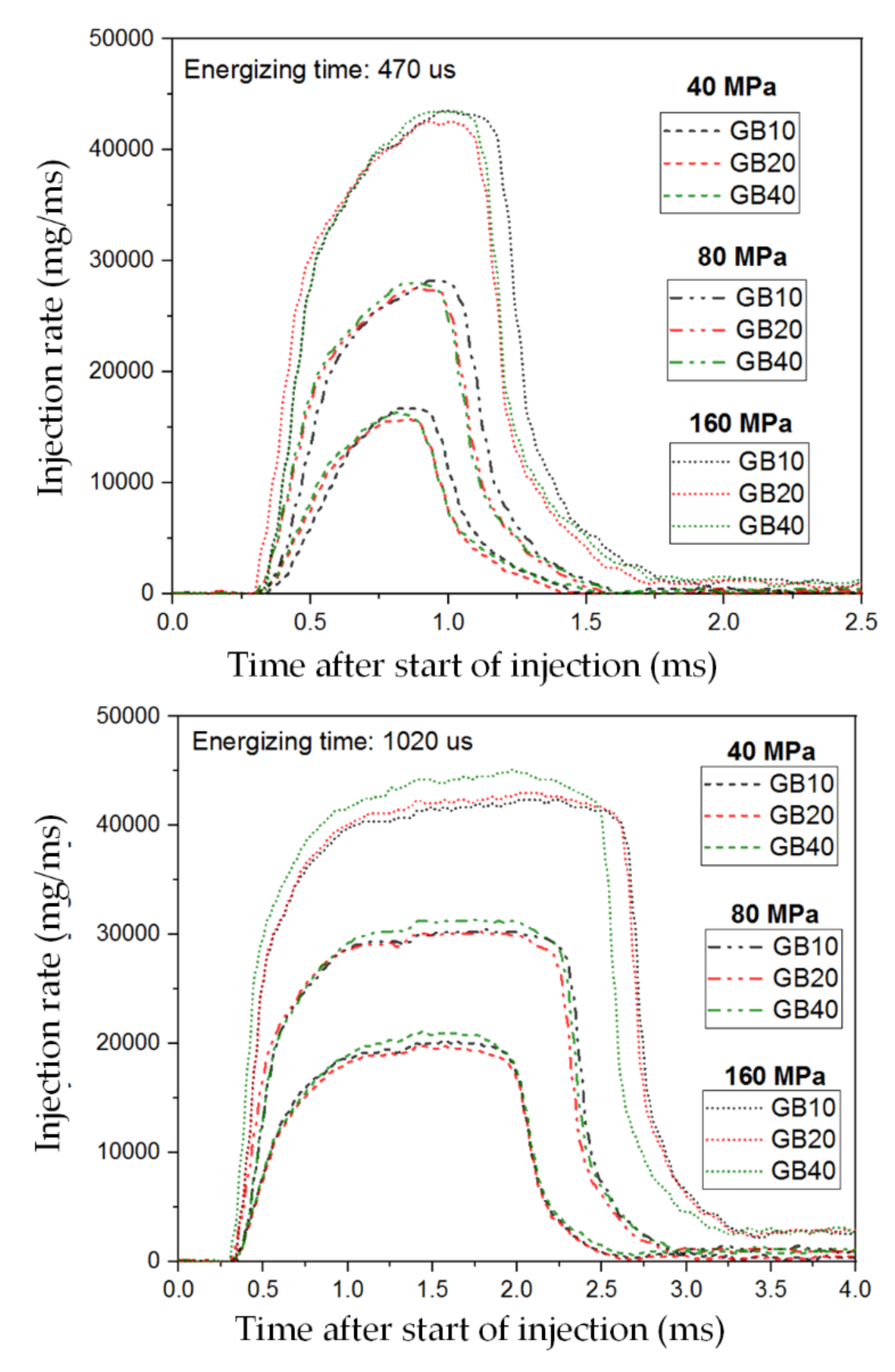

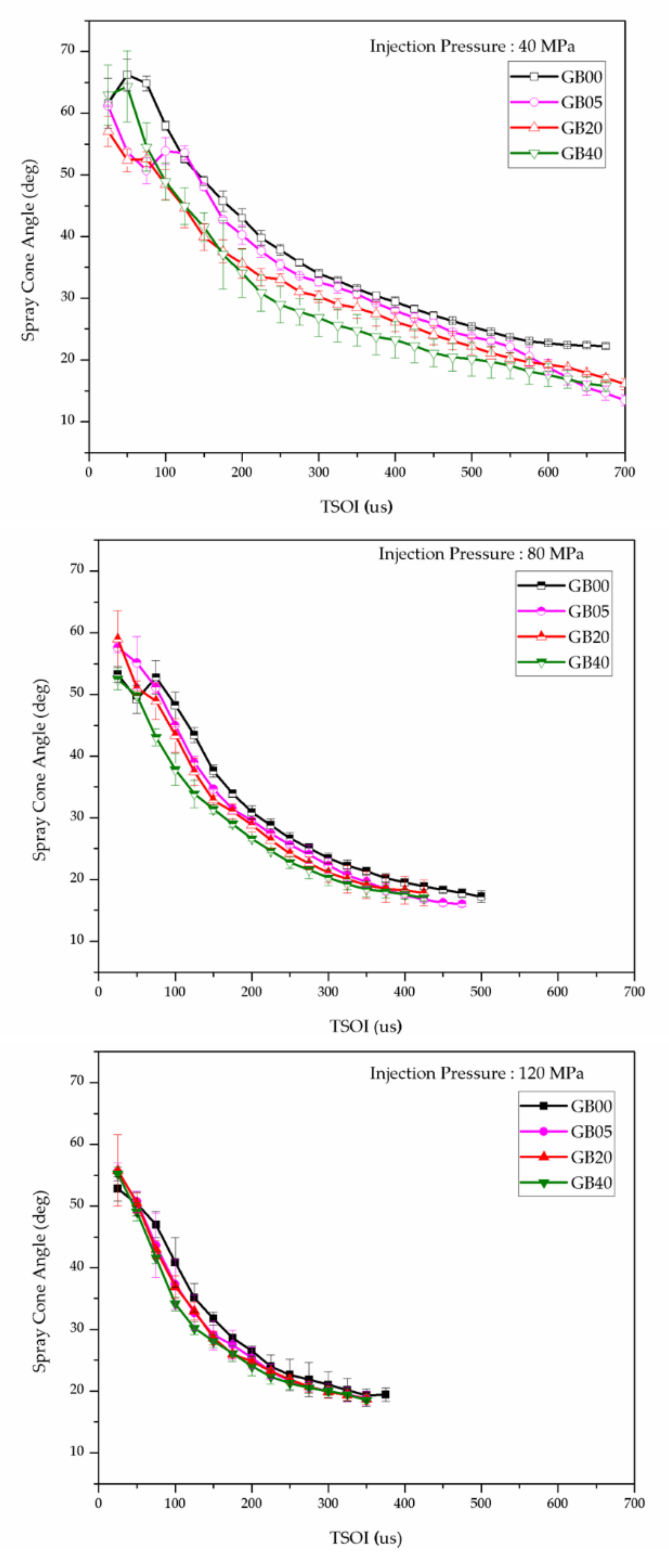
| Property | Unit | Test Method | GB00 | GB05 | GB20 | GB40 | B100 |
|---|---|---|---|---|---|---|---|
| Density at 15 °C | kg/m3 | KS M ISO 12185:2003 | 712.7 | 722.3 | 757.1 | 789.3 | 882.3 |
| Lubricity | mm | KS R ISO 12156-1:2012 | 548 | 290 | 236 | 212 | 189 |
| Cloud point at 15 °C | °C | KS M ISO 3015:2008 | −57 | −57 | −16 | −8 | 3 |
| Kinematic viscosity at 40 °C | mm2/s | KS M ISO 3104:2008 | 0.735 [1] | 0.9097 [2] | 1.4338 [2] | 2.1326 [2] | 4.229 |
| Heating value | MJ/kg | ASTM D240:2009 | 45.86 | 43.6 | 43.6 | 39.79 | |
| Surface tension at 20 °C | mN/m | ASTM D971:2009 | 18.93 [3] | 19.56 [4] | 21.53 [4] | 24.07 [4] | 31.7 [5] |
| Stoichiometric air–fuel ratio | - | 14.7 | 14.276 | 13.852 | 12.58 | ||
| Octane number (RON) | - | 91 [6] | - | - | - | ||
| Cetane number (CN) | - | 16.38 | 23.9 | 31.43 | 54 [7] | ||
| Blend ratio of gasoline | - | 1.0 | 0.95 | 0.80 | 0.60 | - |
| Ambient Conditions | ||
|---|---|---|
| Ambient gas density (kg/m3) | 1.2 | |
| Ambient temperature (K) | 310 | |
| Fuels | GB00, GB05, GB20, GB40 | |
| Fuel temperature (K) | 313 | |
| Injector type | Bosch solenoid CRIN 2 | |
| Nozzle orifice diameter (mm) | 0.30 | |
| Injector nozzle type | Single hole SAC | |
| Injection pressure (MPa) | 40, 80, 120 | |
| Injection duration (µs) | 1000 | |
| Optical setup | Microscopic imaging | Macroscopic imaging |
| Light source | Solid state laser MGL-W-532nm | |
| Frame rate (frame/sec) | 8000 | 40,000 |
| Exposure time (µs) | 0.37 | 3.25 |
| Image resolution (pixel × pixel) | 1024 × 752 | 512 × 256 |
| Scaling factor (mm/pixel) | 0.004 | 0.179 |
| Aperture | f/2.8 | f/2.8 |
© 2020 by the authors. Licensee MDPI, Basel, Switzerland. This article is an open access article distributed under the terms and conditions of the Creative Commons Attribution (CC BY) license (http://creativecommons.org/licenses/by/4.0/).
Share and Cite
Kim, K.; Lim, O. Investigation of the Spray Development Process of Gasoline-Biodiesel Blended Fuel Sprays in a Constant Volume Chamber. Energies 2020, 13, 4819. https://doi.org/10.3390/en13184819
Kim K, Lim O. Investigation of the Spray Development Process of Gasoline-Biodiesel Blended Fuel Sprays in a Constant Volume Chamber. Energies. 2020; 13(18):4819. https://doi.org/10.3390/en13184819
Chicago/Turabian StyleKim, Kihyun, and Ocktaeck Lim. 2020. "Investigation of the Spray Development Process of Gasoline-Biodiesel Blended Fuel Sprays in a Constant Volume Chamber" Energies 13, no. 18: 4819. https://doi.org/10.3390/en13184819
APA StyleKim, K., & Lim, O. (2020). Investigation of the Spray Development Process of Gasoline-Biodiesel Blended Fuel Sprays in a Constant Volume Chamber. Energies, 13(18), 4819. https://doi.org/10.3390/en13184819




